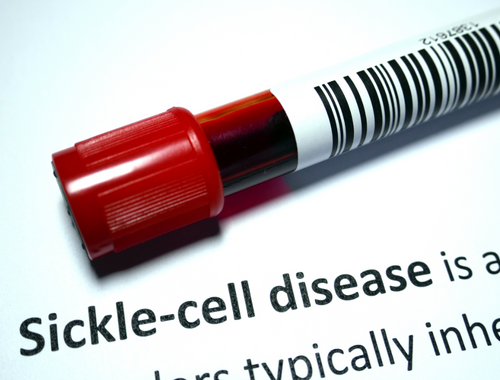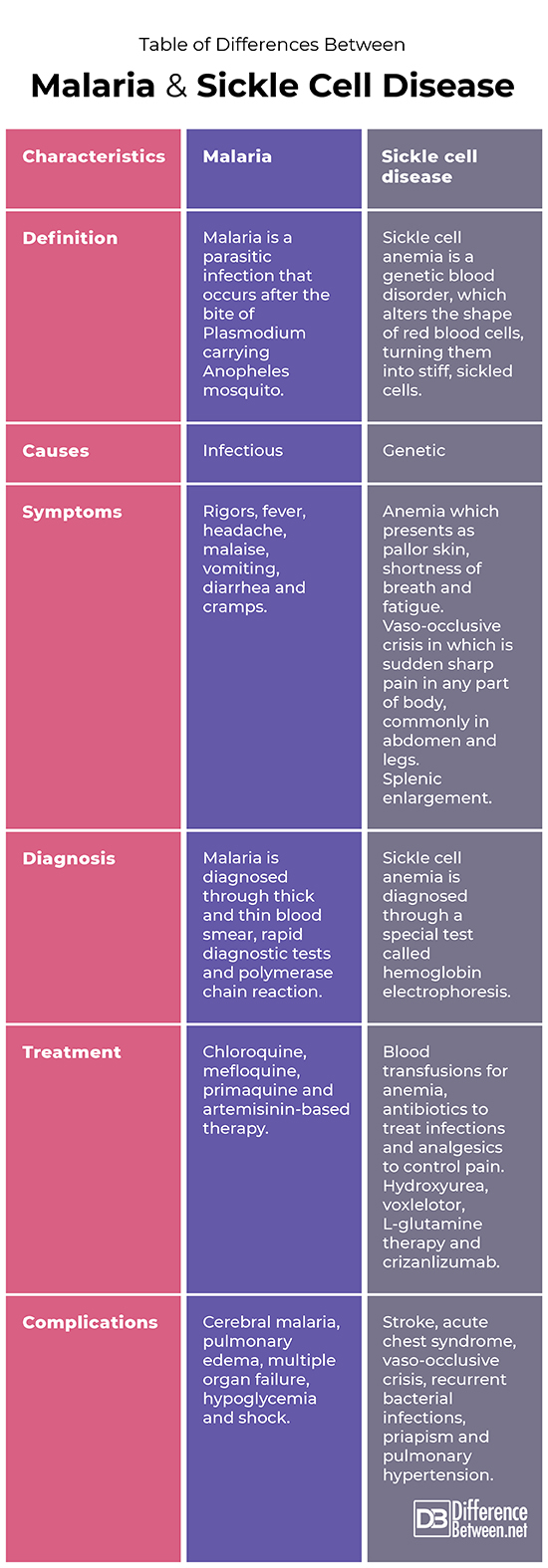Difference Between Malaria and Sickle Cell Anemia
Malaria is a parasitic infection that occurs after the bite of an infected Anopheles mosquito. Sickle cell anemia is a genetic disorder that affects hemoglobin in red blood cells, which eventually results in the abnormal sickled shape of red cells.

What is Malaria?
Definition: Malaria is an infectious disease that occurs when a parasite called plasmodium enters human blood from the bite of mosquitoes called Anopheles.
Cause: Malaria is caused by the bite of a plasmodium-containing mosquito. It is a disease with infectious etiology.
Risk factors: Living in tropical and temperate regions is one of the greatest risk factors for developing malaria. These areas include South America, Sub-Saharan Africa, and South and Southeast Asia. These regions are perfect breeding habitats for Anopheles mosquitoes which carry the malarial parasite. Infants, pregnant women, and travelers are prone to develop malaria.
Symptoms: Typically, patients may have no symptoms until 10 to 20 days after being bitten. The initial symptoms generally comprise rigors, fever, headache, malaise, vomiting, diarrhea, and cramps. Shivering and fever tend to occur in periodic attacks. If these attacks recur at an interval of 48 hours it is called tertian malaria and if at 72 hours it is referred to as quartan malaria.
Diagnosis: The gold standard investigation for malaria diagnosis is a thick and thin blood smear. Other tests include rapid diagnostic tests and polymerase chain reactions.
Treatment: Chief antimalarial drugs are chloroquine, mefloquine, primaquine, and artemisinin-based therapy.
Complications: Complications of malaria include cerebral malaria, pulmonary edema, multiple organ failure, hypoglycemia, and shock.

What is Sickle Cell Anemia?
Definition: Sickle cell anemia is an inherited blood disorder, which alters the shape of red blood cells, turning them into stiff, sickled cells. These sickle-shaped cells have the propensity to stick to each other frequently and also have reduced oxygen-carrying capacity.
Cause: Sickle cell anemia is a purely genetic disorder that manifests when a person inherits the disordered hemoglobin protein gene from both his parents. If only one mutated gene is transferred to the offspring, the recipient is said to have the sickle cell trait.
Symptoms: Sickle cell anemia symptoms typically start to show from infancy. Milder symptoms include anemia which presents as pallor skin, shortness of breath, and fatigue. The disease deteriorates fast and affects various organs of the body. It can cause a vaso-occlusive crisis which is a sudden sharp pain in any part of the body, commonly in the abdomen and legs. Splenic enlargement is a common manifestation of sickle cell anemia.
Diagnosis: Physicians diagnose sickle cell anemia through a special test called hemoglobin electrophoresis. This test easily detects the presence of abnormal hemoglobin in suspected sickle cell patients.
Treatment: Treatment options for sickle cell anemia include blood transfusions for anemia, antibiotics to treat infections, and analgesics to control pain. Important medications that control sickle cell disease quite well include hydroxyurea, voxlelotor, L-glutamine therapy, and crizanlizumab. Stem cell transplantation is a new treatment modality under development.
Complications: Stroke, acute chest syndrome, vaso-occlusive crisis, recurrent bacterial infections, priapism, and pulmonary hypertension are some complications of sickle cell disease.
Difference between Malaria and sickle cell disease:
- Definition: Malaria is a parasitic infection that occurs after the bite of Plasmodium carrying Anopheles mosquito. Sickle cell anemia is a genetic blood disorder, which alters the shape of red blood cells, turning them into stiff, sickled cells.
- Cause: Malaria is an infectious disease whereas sickle cell anemia is an inherited disorder.
- Symptoms: Symptoms of malaria include rigors, fever, headache, malaise, vomiting, diarrhea, and cramps. Symptoms of sickle cell disease include pallor skin, shortness of breath, fatigue, and vaso-occlusive crisis in which there is a sudden sharp pain in the body, commonly in the abdomen and legs.
- Diagnosis: Malaria is diagnosed through thick and thin blood smears, rapid diagnostic tests, and polymerase chain reactions. Sickle cell anemia is diagnosed through a special test called hemoglobin electrophoresis.
- Treatment: Common antimalarial drugs are chloroquine, mefloquine, primaquine, and artemisinin-based therapy. Treatment options for sickle cell anemia include blood transfusions for anemia, antibiotics to treat infections, and analgesics to control pain.
- Complications: Complications of malaria include cerebral malaria, pulmonary edema, multiple organ failure, hypoglycemia, and shock whereas complications of sickle cell disease include stroke, acute chest syndrome, vaso-occlusive crisis, recurrent bacterial infections, priapism, and pulmonary hypertension.
Table of differences between malaria and sickle cell disease

FAQs
Is sickle cell the same as malaria?
Sickle cell anemia and malaria are two completely different diseases. Sickle cell anemia is a genetic disorder whereas malaria is a parasitic infection.
What is the connection between sickle cell disease and malaria?
Having a single mutated hemoglobin gene is called sickle cell trait. Sickle cell trait is protective against malaria; it dampens the detrimental symptoms of malaria.
Why does malaria not affect sickle cell?
The malarial parasite affects red blood cells. People with sickle cell trait already have a proportion of sickle-shaped cells which agglutinate together when infected by a malarial parasite. The body clears these cells and hence malaria is prevented in the carriers.
Why the distribution of sickle cell Anemia and malaria are similar?
Regions, where malaria is endemic, are also the places that have the highest incidence of sickle cell trait. This has occurred due to changes in the genetic coding of hemoglobin over the years.
Who made the correlation between sickle cell and malaria?
J. B. S. Haldane observed the relationship between sickle cell anemia and malaria in the 1940s.
Does malaria select for sickle cell anemia?
Multiple studies depict that certain malarial species, particularly P. falciparum, are selective for sickle cell anemia.
- Differences Between Reptiles and Amphibians - May 17, 2024
- Difference Between Ophthalmology and Optometry - May 15, 2024
- Difference Between Fear and Anxiety - April 2, 2024
Search DifferenceBetween.net :
References :
[0]Britannica, T. "Editors of encyclopaedia." Argon. Encyclopedia Britannica (2020).
[1]Britannica, T. "Editors of encyclopaedia." Argon. Encyclopedia Britannica (2020).
[2]Tuteja, Renu. "Malaria− an overview." The FEBS journal 274.18 (2007): 4670-4679.
[3]Aidoo, Michael, et al. "Protective effects of the sickle cell gene against malaria morbidity and mortality." The Lancet 359.9314 (2002): 1311-1312.
